A Travel Guide to the Sakyamuni Pagoda of Fogong Temple: History, Significance, and Visiting Tips
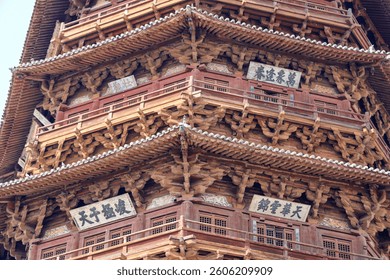
An Essential Guide to Visiting Sakyamuni Pagoda Of Fogong Temple
In This Guide
- An Essential Guide to Visiting Sakyamuni Pagoda Of Fogong Temple
- The Rich History and Legends of Sakyamuni Pagoda Of Fogong Temple
- Main Highlights: What You Absolutely Can’t Miss
- Planning Your Visit: A Practical Guide
- Tickets: Prices, Booking, and Tips
- How to Get There: A Complete Transportation Guide
- Local Cuisine and Accommodation Nearby
- Frequently Asked Questions
- Final Thoughts on Your Trip
Discovering the Architectural Marvel of Ying County
Nestled in the serene landscape of Ying County, the Sakyamuni Pagoda of Fogong Temple stands as a testament to ancient Chinese craftsmanship and spiritual heritage. Constructed in 1056 AD, this remarkable structure is not only the oldest but also the tallest wooden pagoda in the world, soaring to an impressive height of approximately 60 meters. Its unique pavilion-style architecture, constructed entirely without nails, showcases the ingenuity of ancient builders and their profound understanding of wood as a resilient material.
As you approach the pagoda, you’re greeted by a fusion of historical significance and architectural beauty. The pagoda’s wooden beams tell stories of resilience, having withstood the test of time and the ravages of nature, including earthquakes. Though modern assessments have deemed the structure somewhat unstable, its charm remains undiminished, attracting visitors from around the globe.
What to Expect
Visitors are currently allowed to explore only the first level of the pagoda, where a magnificent statue of Sakyamuni Buddha resides, surrounded by intricate wall paintings that reflect the artistry of the era. While the pagoda’s interior access may be limited, the external views offer a captivating glimpse into the grandeur of this ancient edifice.
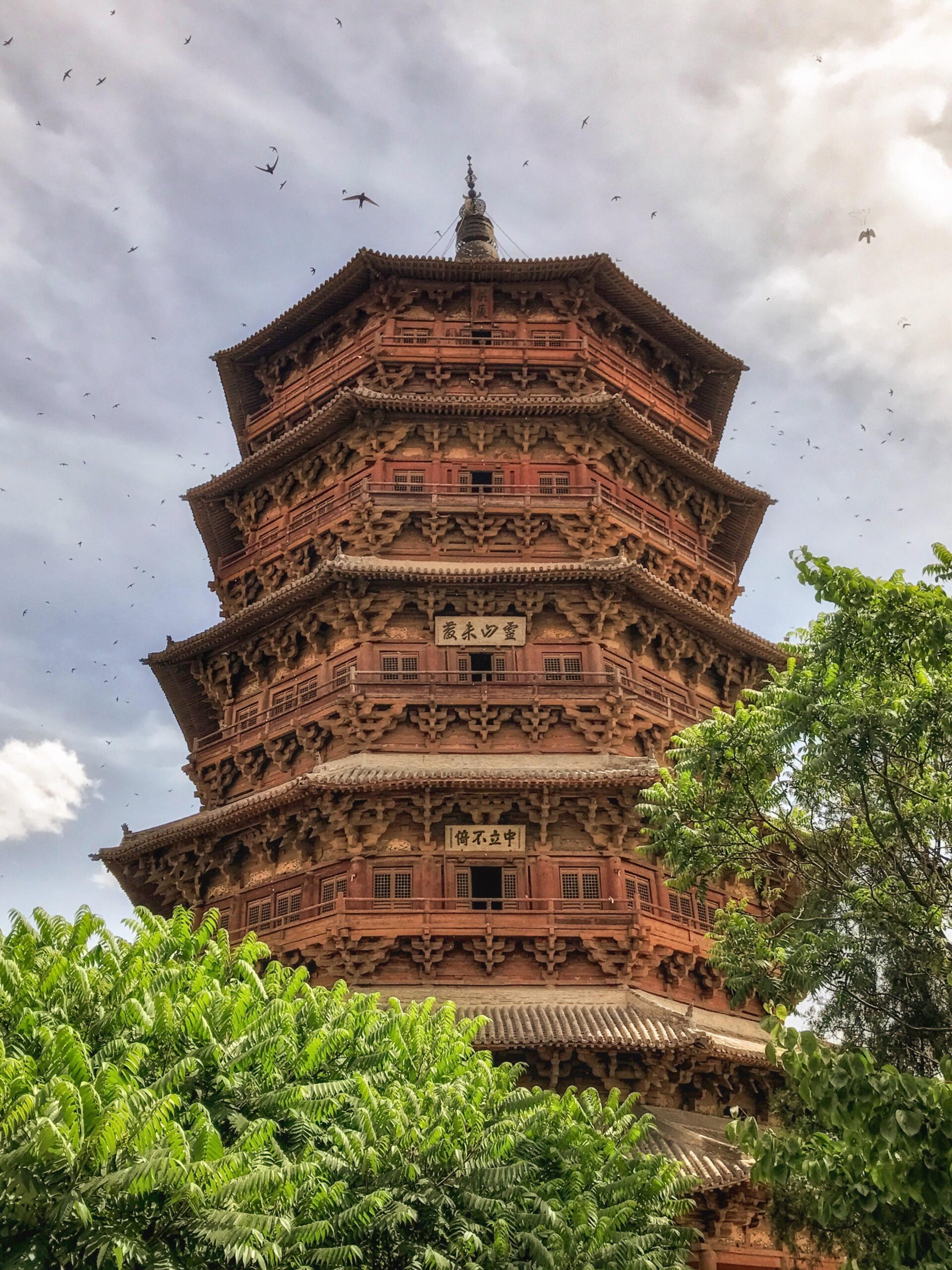
Sakyamuni Pagoda Of Fogong Temple.
Practical Tips for Your Visit
- Best Time to Visit: Spring and autumn offer the most pleasant weather for exploring the site, avoiding the summer heat and winter chill.
- Visiting Hours: Check local listings for updated opening hours, as they may vary seasonally.
- Accessibility: The pagoda is located within the Fogong Temple complex, which includes additional temples and scenic areas worth exploring.
Whether you are a history buff, an architecture enthusiast, or simply seeking a tranquil escape, the Sakyamuni Pagoda of Fogong Temple promises a profound experience steeped in Chinese culture and spirituality. Prepare to be awed by this architectural marvel that has stood tall for nearly a millennium, inviting you to uncover the stories hidden within its wooden walls.
The Rich History and Legends of Sakyamuni Pagoda Of Fogong Temple
A Journey Through Time: The Sakyamuni Pagoda of Fogong Temple
Nestled in the serene landscape of Ying County, the Sakyamuni Pagoda of Fogong Temple (佛宫寺释迦塔) stands as a monumental testament to ancient Chinese architectural ingenuity and Buddhist devotion. Constructed in 1056 AD, this pagoda is not only the oldest but also the tallest wooden structure of its kind in China, reaching an impressive height of approximately 60 meters. Its enduring presence through centuries of natural disasters and political upheaval has made it a symbol of resilience and spiritual significance.
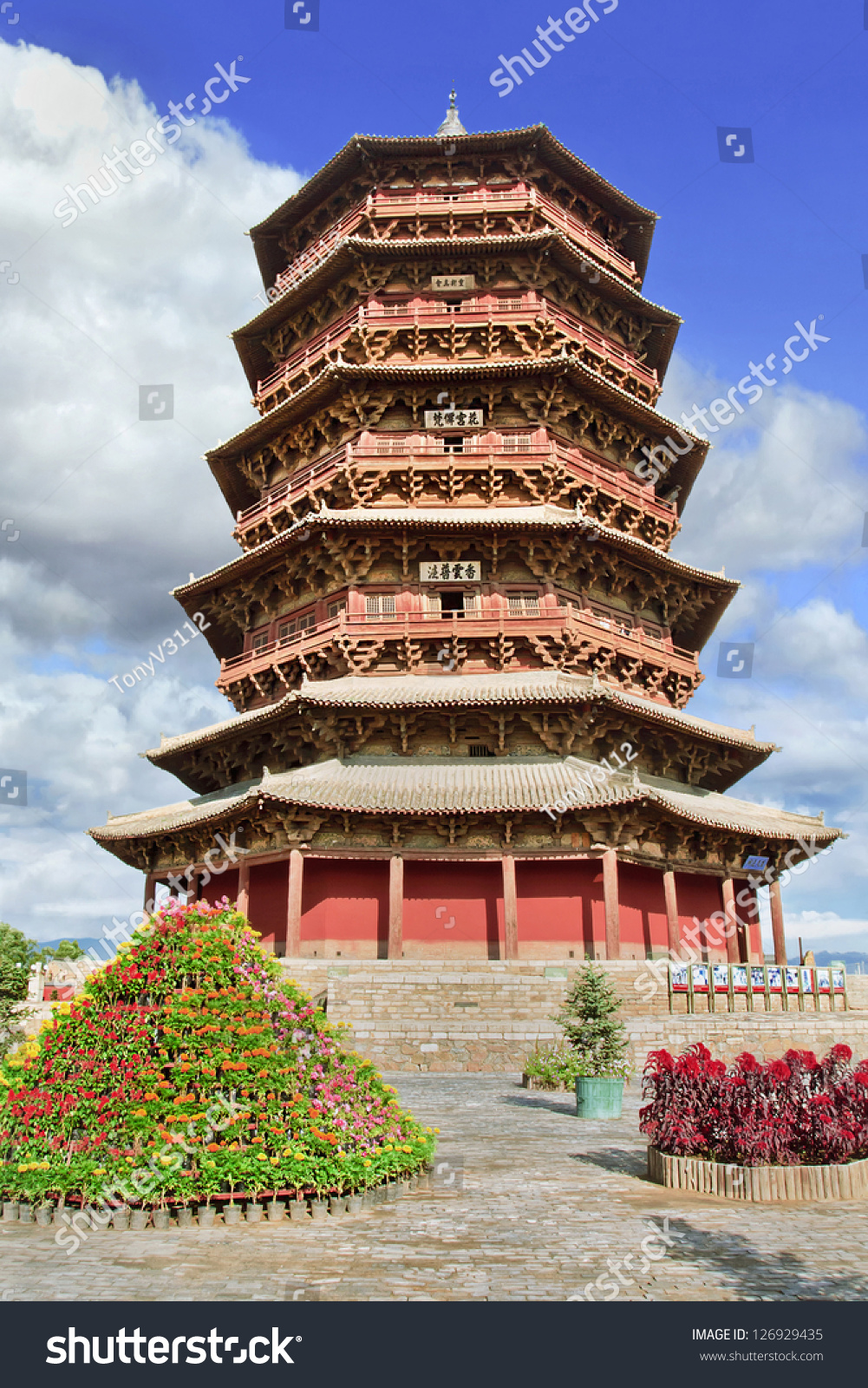
Sakyamuni Pagoda Of Fogong Temple.
Architectural Marvel
The Sakyamuni Pagoda is renowned for its unique construction technique. Remarkably, it is built entirely of wood without the use of nails, employing a traditional method that allows for flexibility during earthquakes. This innovative design has contributed to its survival despite the ravages of time and nature. Visitors today can admire its striking pavilion-style architecture, characterized by intricate wooden carvings and elegant eaves that extend outward, giving it a delicate yet robust appearance.
Historical Significance
Beyond its architectural brilliance, the pagoda holds deep historical value. It originally served as a reliquary for the sacred remains of the Buddha, with the statue of Sakyamuni Buddha housed within its walls. Although visitors are no longer permitted to enter the pagoda due to stability concerns, they can still appreciate the grandeur of the large Buddha statue located on the first floor, surrounded by beautifully painted murals that narrate Buddhist tales.
Over the centuries, the Sakyamuni Pagoda has withstood numerous earthquakes and has become a focal point for the local Buddhist community. Pilgrims and monks often visit, paying homage to the pagoda’s sacred heritage. Notably, in recent years, the sight of Tibetan monks at the temple has drawn interest, highlighting the pagoda’s continued significance in the broader Buddhist world.
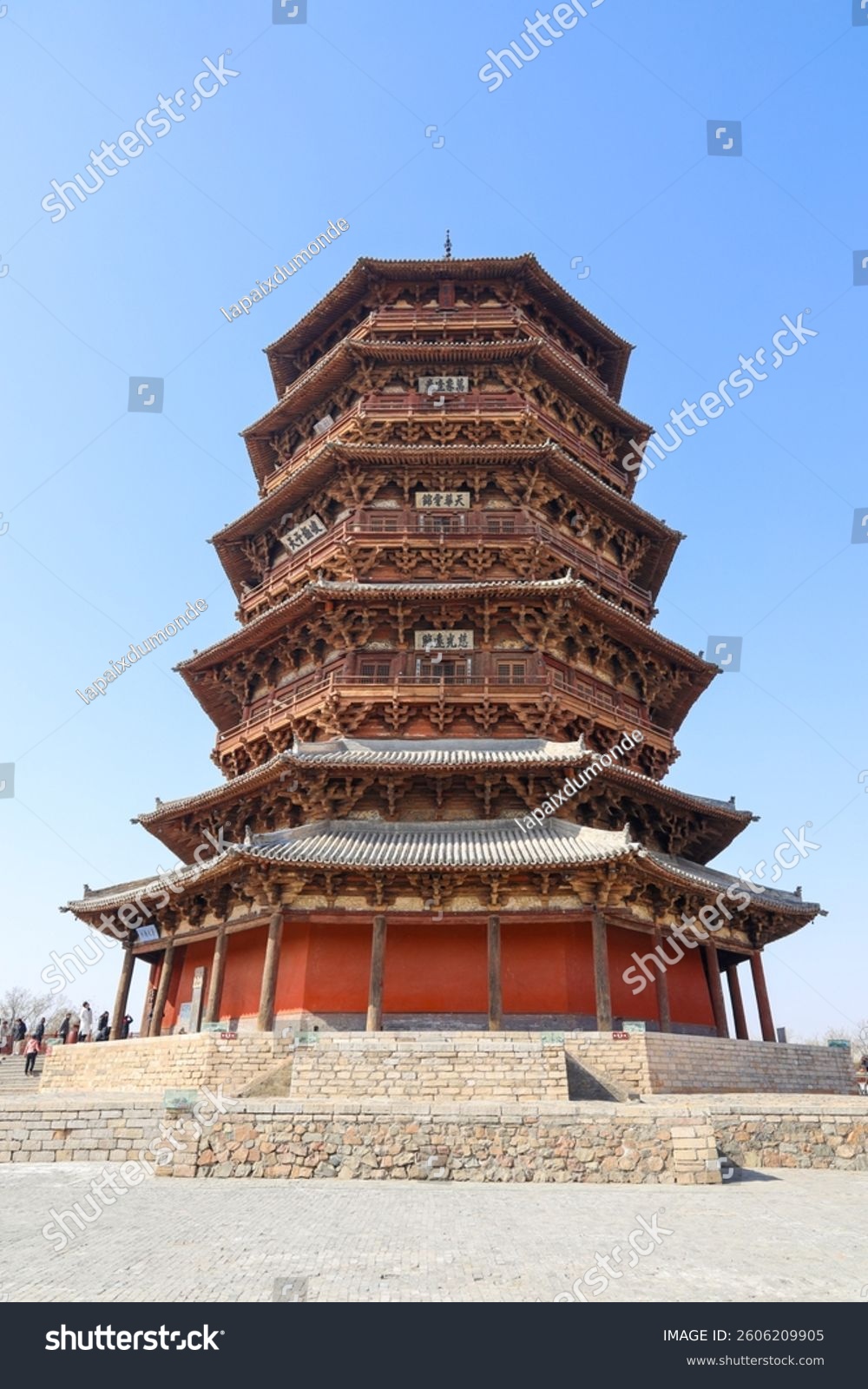
Sakyamuni Pagoda Of Fogong Temple.
Legends and Myths
The lore surrounding the Sakyamuni Pagoda is as rich as its history. One popular legend tells of a miraculous event during its construction. It is said that the master carpenter, facing challenges with the intricate design, prayed fervently to the Buddha for guidance. That night, he dreamt of the Buddha himself, who revealed the secrets of the pagoda’s construction. Inspired by this divine intervention, the carpenter completed the pagoda, which has since been revered as a sacred site.
Another legend speaks of the pagoda’s mystical ability to protect the village from calamities. Locals believe that as long as the pagoda stands, it will safeguard the community from disasters like floods and earthquakes, further solidifying its role as a spiritual beacon.
Visiting Today
While the interior of the Sakyamuni Pagoda is now off-limits to the public, visitors can still explore the surrounding complex and appreciate the natural beauty of the site. The adjacent Fogong Temple offers a glimpse into the serene practices of Buddhism, with tranquil gardens and prayer halls inviting contemplation and reflection.
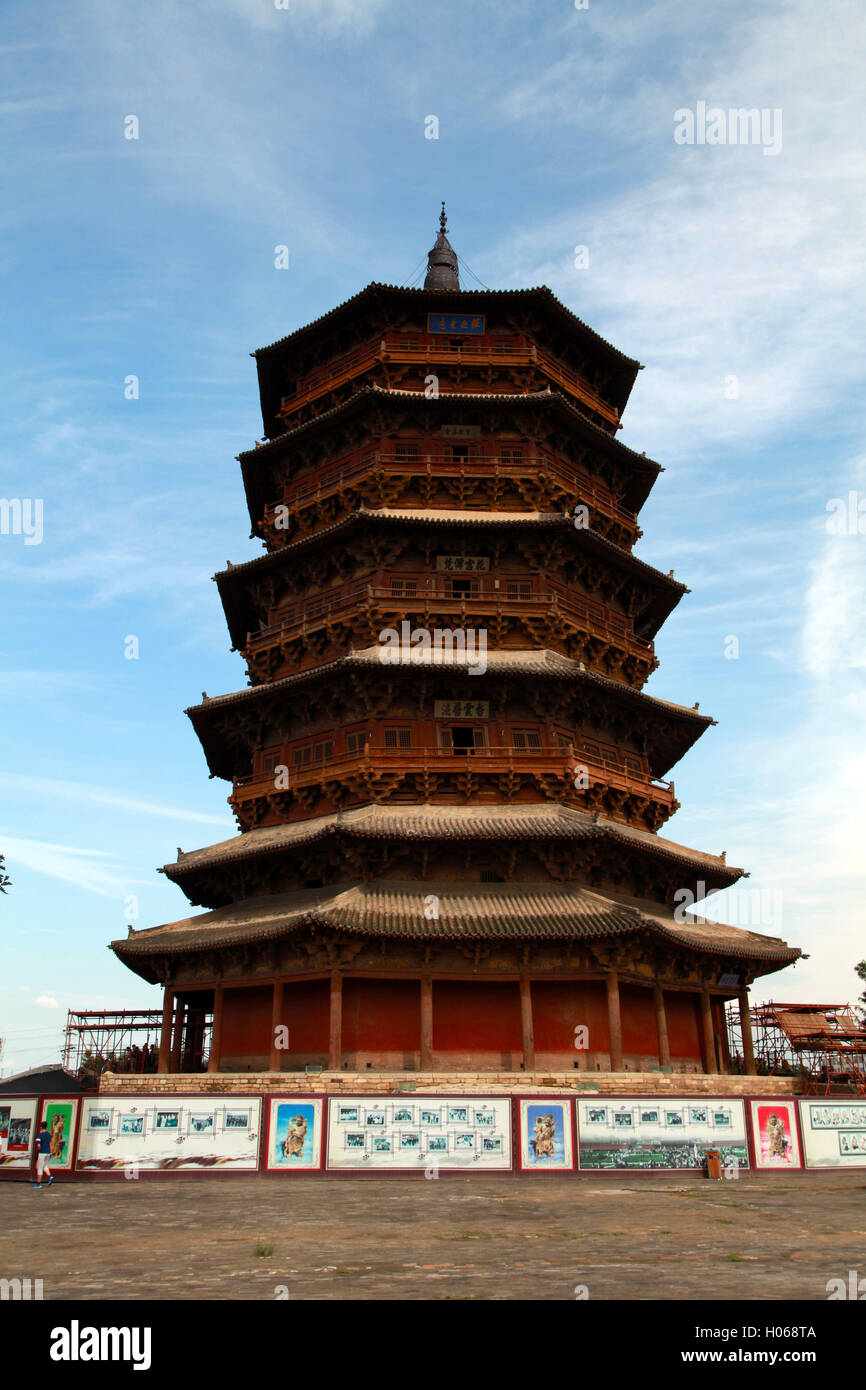
Sakyamuni Pagoda Of Fogong Temple.
For those venturing to this historical site, consider joining a guided tour to enrich your experience. Tours often combine visits to nearby attractions, such as the Hanging Temple and the Yungang Grottoes, creating a deeper understanding of the region’s rich cultural tapestry.
The Sakyamuni Pagoda of Fogong Temple is more than just an architectural wonder; it is a living piece of history and a monument to the enduring legacy of Chinese culture and spirituality. Whether you are an architecture aficionado, a history buff, or a seeker of spiritual enlightenment, this remarkable pagoda promises to leave a lasting impression.
Main Highlights: What You Absolutely Can’t Miss
Discover the Wonders of the Sakyamuni Pagoda of Fogong Temple
When exploring the treasures of Chinese history and architecture, the Sakyamuni Pagoda of Fogong Temple (佛宫寺释迦塔) in Ying County stands out as an unmissable highlight. Here are the key features and experiences that make this remarkable site a must-visit.

Sakyamuni Pagoda Of Fogong Temple.
Architectural Marvel
- Oldest and Tallest Wooden Pagoda: Constructed in 1056 AD, this pagoda is the oldest existing wooden pagoda in China, showcasing exquisite craftsmanship without the use of nails. Its impressive height of approximately 67.31 meters (220 feet) makes it the tallest wooden structure of its kind in the world.
- Unique Construction: The pagoda is built entirely of timber, relying on traditional engineering techniques that have allowed it to withstand centuries of wear and tear, including the tremors of earthquakes. Look closely to appreciate the intricate details of its pavilion-style architecture, which reflects the sophisticated design principles of the Song Dynasty.
Cultural Significance
- Buddhist Heritage: As a significant site for Buddhist worship, the pagoda houses a grand statue of Sakyamuni Buddha on the first level, providing a serene atmosphere for reflection. Although access to the upper levels has been restricted due to safety concerns, the first floor remains a focal point of reverence and admiration.
- Artistic Displays: Visitors can admire beautiful wall paintings that adorn the interior, offering a glimpse into the rich artistic traditions associated with Buddhist practice.
Visitor Experience
- Walking Around the Pagoda: While you may not be able to ascend the pagoda, take the opportunity to stroll around the base and admire the structure from different angles. Note the subtle slant in some sections—a testament to its age and resilience.
- Cultural Interactions: You might encounter local monks or visitors engaged in prayer and meditation, adding to the cultural richness of your visit. Be respectful and mindful of the spiritual environment.
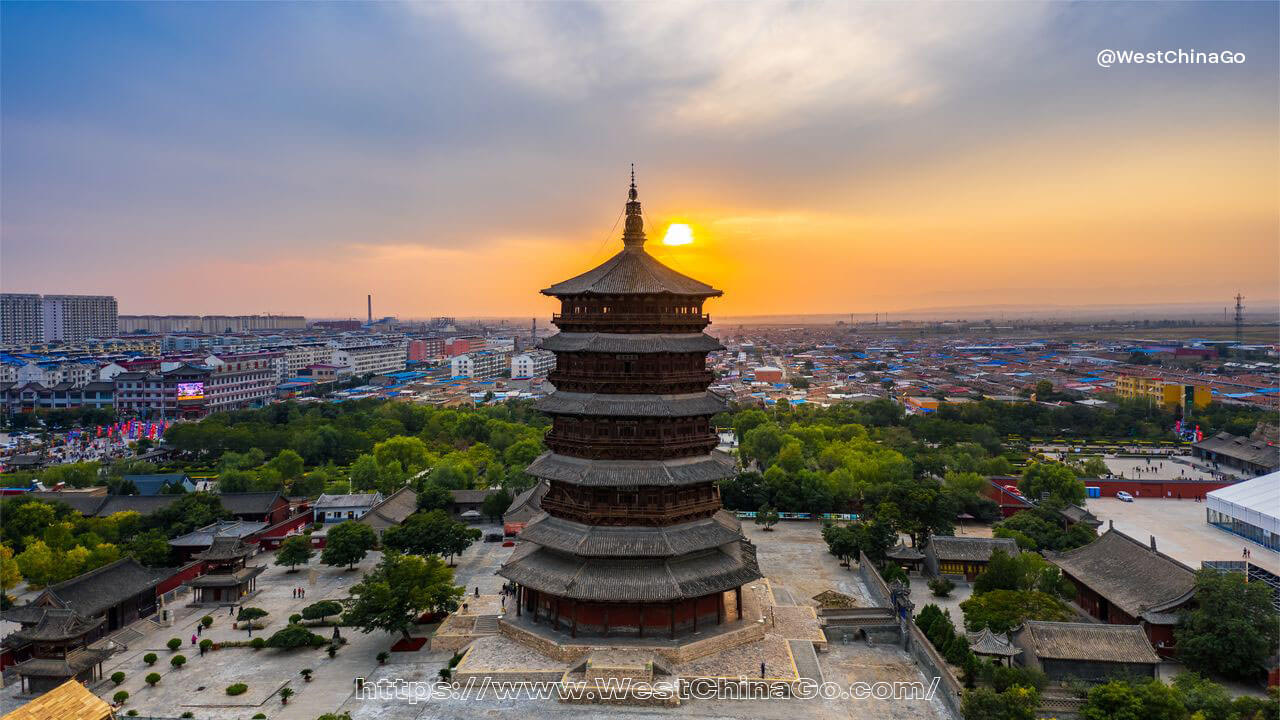
Sakyamuni Pagoda Of Fogong Temple.
Practical Information
- Location: The Sakyamuni Pagoda is located within the West Street City Fogong Temple complex in Ying County, making it easily accessible for travelers in the region.
- Nearby Attractions: Combine your visit with trips to the nearby Hanging Temple and Yungang Grottoes to experience more of the area’s historical and architectural wonders.
Tips for Your Visit
- Timing: To avoid crowds, consider visiting during the early morning or late afternoon. This will enhance your experience and allow for better photo opportunities.
- Dress Appropriately: As a place of worship, dress modestly and respectfully during your visit.
- Plan Ahead: Given the popularity of the site, it may be wise to book a guided tour that includes the pagoda, especially if you’re traveling from afar.
The Sakyamuni Pagoda of Fogong Temple not only represents a pinnacle of ancient Chinese architecture but also serves as a profound reminder of the enduring legacy of Buddhism in China. Whether you are a history buff, an architecture enthusiast, or simply looking for a serene place to reflect, this pagoda promises an enriching experience that you won’t soon forget.
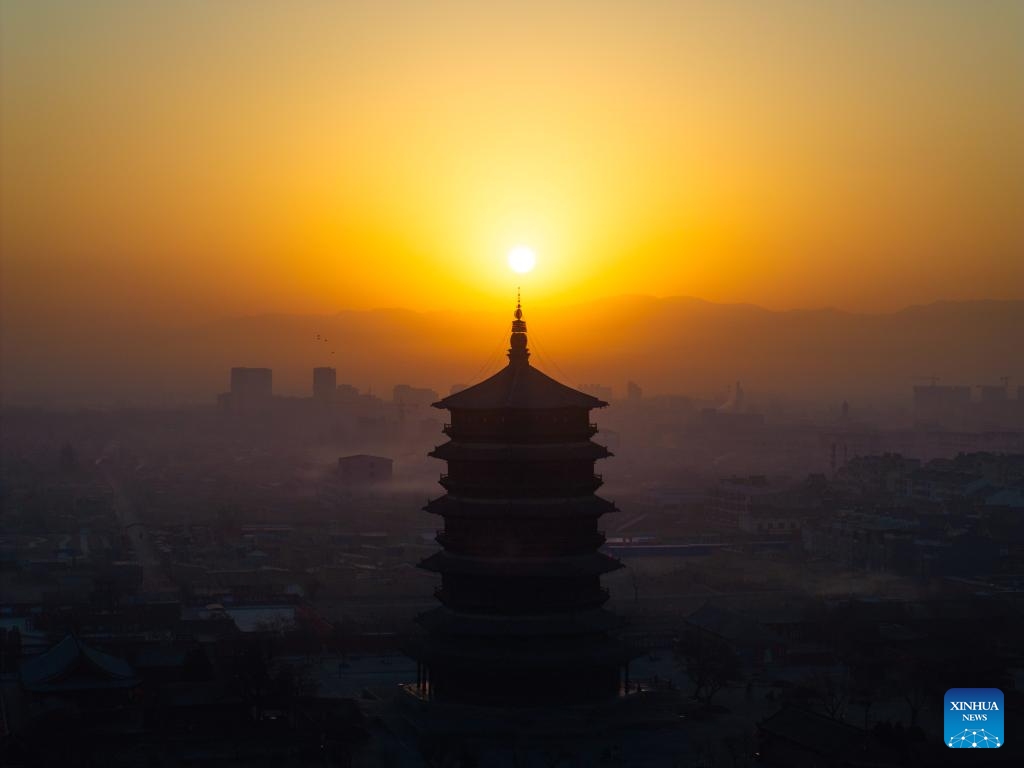
Sakyamuni Pagoda Of Fogong Temple.
Planning Your Visit: A Practical Guide
Visiting the Sakyamuni Pagoda of Fogong Temple: A Comprehensive Guide
The Sakyamuni Pagoda of Fogong Temple, located in Ying County, is a magnificent testament to ancient Chinese architecture and Buddhist heritage. As the oldest and tallest wooden structure in China, it draws history enthusiasts and cultural travelers alike. Here’s everything you need to know to make the most of your visit.
Getting There
- Location: The pagoda is situated inside the Fogong Temple complex at West Street, Ying County, Shanxi Province, China.
- Transportation:
- From Datong: The pagoda is approximately 60 kilometers (about 37 miles) from Datong, accessible by car or bus. Private tours often include transportation, which can be a convenient option.
- Public Transport: Buses run regularly from Datong to Ying County; however, check schedules in advance, as they can vary.

Sakyamuni Pagoda Of Fogong Temple.
Opening Hours and Entry
- Visiting Hours: The site is generally open from 8:00 AM to 5:00 PM. It’s advisable to arrive early to avoid crowds, especially during peak tourist seasons.
- Entry Fees: There is usually a nominal fee for entry to the temple complex. Be prepared for potential increases during holidays or peak seasons.
What to Expect
- Architectural Marvel: The Sakyamuni Pagoda, built in 1056 AD, stands at an impressive 67.31 meters (220.1 feet). It is constructed entirely of wood without the use of nails, showcasing ancient Chinese engineering techniques that have allowed it to withstand earthquakes over centuries.
- Interior Access: Currently, visitors are permitted only on the first floor, where you can admire a large statue of Sakyamuni Buddha and exquisite wall paintings. Due to structural concerns, access to the upper levels has been restricted.
- Photography: While photography is generally allowed, be mindful of other visitors and local customs, particularly if you encounter groups such as Tibetan monks, who may prefer to maintain their privacy.
Visitor Tips
- Timing Your Visit: Consider visiting during the weekdays or off-peak seasons (spring and autumn) for a quieter experience.
- Nearby Attractions: Don’t miss the adjacent Fogong Temple, which also offers insight into the region’s Buddhist practices and architecture.
- Plan for Weather: The area can get quite hot in summer; bring water, wear comfortable clothing, and take breaks as needed.
- Respect Local Customs: As a religious site, maintain a respectful demeanor, particularly in prayer areas.
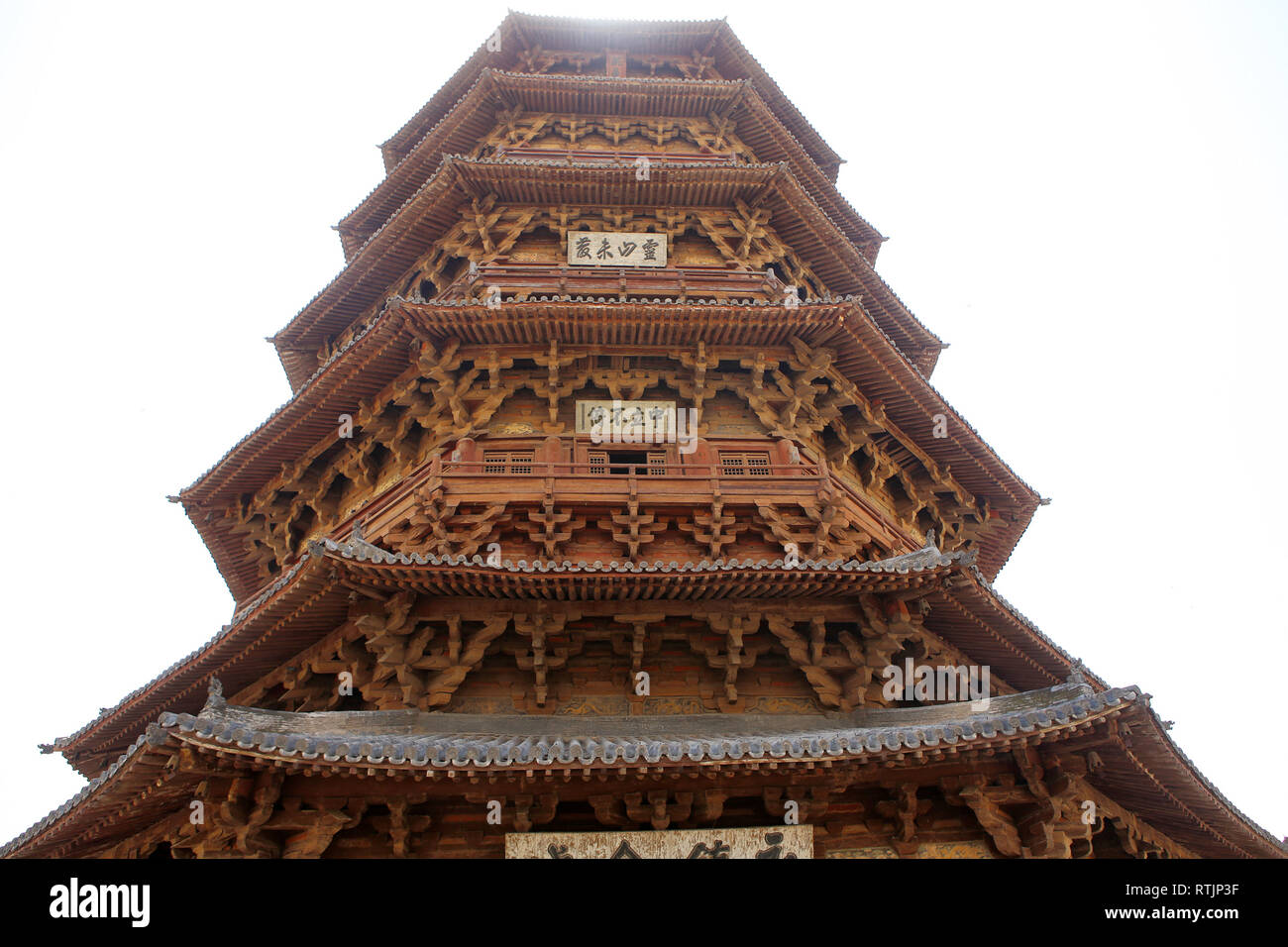
Sakyamuni Pagoda Of Fogong Temple.
Recommended Tours
For those who prefer a guided experience, several tour options are available:
- Private Day Tours: These typically include visits to the Hanging Temple and other local attractions, allowing you to explore the region’s rich history with a knowledgeable guide.
- Multi-Day Tours: If you have more time, consider tours that encompass other historical sites such as the Yungang Grottoes, providing a broader context of Shanxi’s cultural heritage.
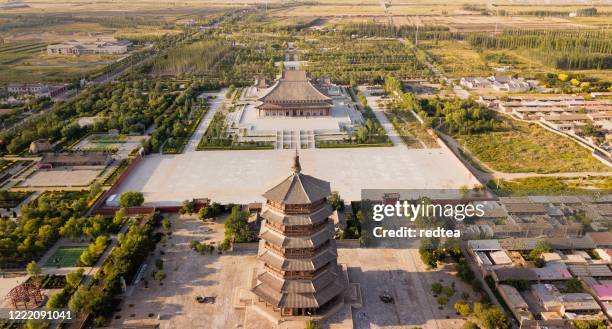
Sakyamuni Pagoda Of Fogong Temple.
Nearby Dining Options
After your exploration, you may want to enjoy a meal at one of the nearby restaurants. While specific recommendations vary, look for local eateries offering traditional Shanxi cuisine, known for its hand-pulled noodles and hearty flavors.
Conclusion
The Sakyamuni Pagoda of Fogong Temple is not just a site of architectural wonder; it’s a journey into China’s profound history and cultural depth. With careful planning and an appreciation for the site’s significance, your visit can be a memorable experience that enriches your understanding of Chinese heritage.
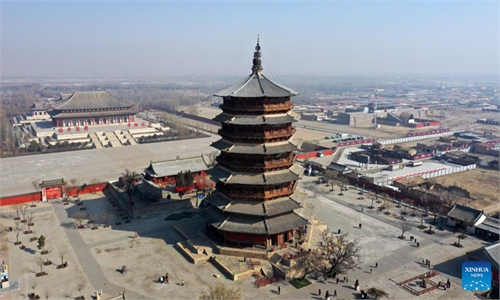
Sakyamuni Pagoda Of Fogong Temple.
Tickets: Prices, Booking, and Tips
Planning Your Visit to the Sakyamuni Pagoda of Fogong Temple
Visiting the Sakyamuni Pagoda of Fogong Temple is an enriching experience that immerses you in China’s rich history and architectural marvels. Here’s everything you need to know about ticket prices, booking options, and tips for making the most of your visit.
Ticket Prices
As of now, the entrance to the Sakyamuni Pagoda is typically included in the general ticket to the Fogong Temple complex. While prices may vary, you can expect to pay around 60-100 CNY (approximately $10-15 USD) for adults. Discounts may be available for seniors, students, and children, so it’s worth asking at the ticket counter.

Sakyamuni Pagoda Of Fogong Temple.
Booking Information
While tickets can often be purchased on-site, to avoid long lines—especially during peak tourist seasons—consider booking your tickets in advance. Several reputable travel platforms offer ticket reservations. Alternatively, guided tours that include the pagoda often incorporate ticket costs, providing a seamless experience.
Guided Tours
For a deeper understanding of this historical site, consider joining a guided tour. Options include:
- Private Day Tours: These typically last 8-10 hours and can cost between $220 to $600 USD, depending on the inclusions.
- Multi-Day Tours: If you plan to explore more of Datong, consider a 2-day tour which includes the pagoda and other nearby attractions, starting from approximately $400 to $800 USD.
Tips for Your Visit
- Best Time to Visit: Early morning or late afternoon are ideal to avoid crowds and enjoy softer light for photography.
- Exploration Limitations: Currently, due to structural concerns, visitors are only allowed on the first floor of the pagoda, which features a striking Sakyamuni Buddha statue. Visitors should manage expectations about interior access.
- Respect Local Customs: As the pagoda is a sacred site, it’s important to maintain a respectful demeanor, especially during religious ceremonies or when monks are present.
- Photography: While capturing memories is encouraged, be mindful of sensitivity around photography, especially with certain groups or individuals.
- Nearby Attractions: Plan to visit adjacent sites, such as the surrounding temples and natural landmarks, to fully appreciate the cultural richness of the area.
By preparing in advance and following these guidelines, your visit to the Sakyamuni Pagoda of Fogong Temple will be both enjoyable and educational, allowing you to appreciate one of China’s most remarkable historical structures.
How to Get There: A Complete Transportation Guide
Reaching the Sakyamuni Pagoda of Fogong Temple
Visiting the Sakyamuni Pagoda of Fogong Temple is a journey back in time, offering travelers a glimpse into China’s rich architectural heritage and spiritual history. The pagoda, recognized as the oldest and tallest wooden structure in the country, is located in Ying County, Shanxi Province. Here’s a comprehensive guide to help you navigate your way to this historical landmark.
Getting to Datong
By Air:
The nearest major airport is Datong Yungang Airport (DAT), which is about 18 kilometers from the city center. Domestic flights connect Datong with major cities like Beijing and Shanghai. From the airport, you can take a taxi or a pre-arranged shuttle service to reach Datong city.
By Train:
Datong Railway Station is well-connected to several cities across China. High-speed trains run from Beijing, taking approximately 2 to 3 hours. Once you arrive at Datong Railway Station, you can easily find taxis or public buses to continue your journey to the pagoda.
By Bus:
For those traveling from surrounding cities, long-distance buses are available. Datong has a central bus station with services connecting to nearby towns and cities.
Journey to Ying County
Once in Datong, Ying County is approximately 60 kilometers away. Here are your options for getting there:
By Taxi:
The most convenient option is to take a taxi directly from Datong to the Sakyamuni Pagoda. The journey typically takes about 1 hour. Make sure to negotiate the fare beforehand or use a ride-hailing app if available.
By Bus:
Buses run from Datong’s central bus station to Ying County. Look for buses labeled for Ying County or specifically for the Pagoda. The bus ride will take around 1.5 to 2 hours, depending on traffic conditions.
By Private Tour:
For a more personalized experience, consider booking a private tour that includes transportation. Many tour operators in Datong offer packages that cover the Sakyamuni Pagoda, the Hanging Temple, and other nearby attractions. This is an excellent option for those who wish to explore without the hassle of public transport.
Local Navigation
Upon reaching Ying County, the Sakyamuni Pagoda is situated within the Fogong Temple complex. Here’s how to find it:
- Walking: The pagoda is accessible on foot from the bus drop-off point or taxi stand within the temple grounds. Follow the signs leading to the pagoda.
- Guided Tours: Many visitors opt for guided tours that provide transportation within the temple complex, allowing you to learn more about the pagoda’s history as you explore.
Tips for Travelers
- Check Opening Hours: Ensure to check the pagoda’s opening hours before your visit, as they may vary seasonally.
- Respect Local Customs: As a site of religious significance, it is important to dress modestly and respect the local customs while visiting the temple.
- Stay Hydrated: If visiting during the summer months, carry water with you, as the walk around the temple grounds can be quite warm.
By following this guide, you will be well-equipped to explore the Sakyamuni Pagoda of Fogong Temple and immerse yourself in the rich tapestry of Chinese history that it represents. Enjoy your journey!
Local Cuisine and Accommodation Nearby
Discovering Ying County’s Culinary Delights and Comfortable Stays
Visiting the Sakyamuni Pagoda of Fogong Temple is not just about immersing yourself in its historical grandeur; it’s also an opportunity to savor the local cuisine and enjoy comfortable accommodations nearby. The area surrounding this remarkable wooden pagoda, built in 1056 AD, offers a rich tapestry of flavors and experiences that will enhance your trip.
Local Cuisine
Ying County’s culinary scene is a delightful blend of traditional Chinese flavors, often featuring hearty dishes that reflect the region’s agricultural heritage. Here are some must-try local delicacies:
-
Yingxian Noodles (应县炸酱面): A staple of the local diet, these hand-pulled noodles are typically served with a rich, savory bean paste sauce and garnished with fresh vegetables. Perfect for a filling lunch after exploring the pagoda.
-
Beef and Lamb Skewers (烤羊肉串): Often found in street food stalls, these skewers are marinated in a mix of spices and grilled to perfection. They make for a delicious snack while you wander around the area.
-
Suan Ni Bai Rou (蒜泥白肉): This cold dish features thinly sliced pork belly served with a zesty garlic sauce. It’s a refreshing choice, particularly during the warmer months.
-
Stuffed Buns (包子): These steamed buns come with various fillings, from pork to vegetables, and are a favorite among locals for breakfast or as a quick snack.
For a true taste of local dining, consider visiting Ying County Food Street where you can find a variety of restaurants and street vendors offering these traditional dishes.
Recommended Accommodations
After a day spent exploring the wonders of the Sakyamuni Pagoda and its surroundings, a good night’s rest is essential. Here are some recommended places to stay nearby:
- Datong Jinjiang International Hotel (晋江国际酒店)
- Description: This upscale hotel is known for its comfortable rooms and modern amenities, making it a great base for exploring the region. The hotel also features a restaurant that serves both local and international dishes.
-
Location: Approximately 20 minutes by car from the pagoda.
-
Ying County Hotel (应县宾馆)
- Description: A more budget-friendly option, this hotel offers clean accommodations and basic amenities. It provides a cozy atmosphere and is conveniently located near local attractions.
-
Location: Just a short walk from the pagoda.
-
Datong Yungang International Hotel (大同云岗国际酒店)
- Description: Featuring spacious rooms and a swimming pool, this hotel is ideal for families and those looking to relax after a day of sightseeing. The on-site restaurant serves a variety of dishes, including local specialties.
-
Location: About 30 minutes from the pagoda, but well worth the travel for its amenities.
-
Hostel Choices: For travelers on a budget, there are several hostels in the area that offer dormitory-style accommodations. These are great places to meet other travelers and share stories from your journeys.
With a plethora of culinary delights to sample and comfortable accommodations to rest your head, your visit to the Sakyamuni Pagoda of Fogong Temple can be an enriching experience that goes beyond the historical. Enjoy the flavors and hospitality of Ying County as you delve deeper into China’s vibrant culture!
Frequently Asked Questions
Frequently Asked Questions about the Sakyamuni Pagoda of Fogong Temple
1. What is the historical significance of the Sakyamuni Pagoda?
The Sakyamuni Pagoda, constructed in 1056 AD, is renowned as the oldest and tallest wooden pagoda in China. This architectural marvel exemplifies ancient Chinese craftsmanship, particularly its unique use of no nails in construction, which has allowed it to withstand numerous earthquakes over the centuries.
2. Where is the Sakyamuni Pagoda located?
The pagoda is situated within the Fogong Temple complex in Ying County, Shanxi Province, China. It is easily accessible from Datong, making it a popular day trip destination for both domestic and international travelers.
3. Can visitors go inside the pagoda?
Currently, visitors are not allowed to enter the pagoda due to safety concerns regarding its structural integrity. However, tourists can walk around the first floor, where they can admire a large statue of Sakyamuni Buddha and beautiful wall paintings.
4. How tall is the Sakyamuni Pagoda?
The pagoda stands approximately 67.31 meters (220 feet) tall, making it the tallest wooden structure of its kind in the world. Its impressive height and intricate design draw many visitors each year.
5. What should I expect during my visit?
Visitors can enjoy the serene atmosphere of the temple grounds and take photos of the pagoda from various angles. Be prepared for potential crowds, especially during peak tourist seasons, as the site is a popular attraction.
6. Are there any nearby attractions worth visiting?
Yes! In addition to the Sakyamuni Pagoda, nearby attractions include the Hanging Temple and the Yungang Grottoes, both of which showcase remarkable examples of ancient Chinese architecture and artistry. Many guided tours include these sites in their itineraries.
7. How can I get to the Sakyamuni Pagoda?
The pagoda is easily accessible from Datong by car or public transportation. Numerous tour operators offer day trips that include transportation, making it convenient for travelers looking to explore the area.
8. Is there an entry fee for visiting the Sakyamuni Pagoda?
Yes, there is an admission fee to enter the Fogong Temple complex, which includes access to the pagoda grounds. It’s advisable to check the latest information regarding ticket prices and opening hours before your visit.
Final Thoughts on Your Trip
As your journey to the Sakyamuni Pagoda of Fogong Temple comes to a close, it’s essential to reflect on the rich tapestry of history, culture, and architectural marvel that this ancient site offers.
A Journey Through Time
Standing since 1056 AD, the Sakyamuni Pagoda is not merely the tallest wooden pagoda in the world; it is a testament to the ingenuity and resilience of Chinese craftsmanship. Made entirely of wood and built without a single nail, this remarkable structure has weathered countless storms, both literal and metaphorical, maintaining its dignity through the centuries.
Cultural Significance
Visitors to the pagoda experience a profound connection to the past. As you gaze upon the towering edifice, consider the countless monks and pilgrims who have walked these grounds, seeking solace and enlightenment. The intricate carvings and the serene presence of the Sakyamuni Buddha statue on the first floor invite contemplation and reverence.
Practical Insights
While access to the interior has become limited due to safety concerns, the view from the outside is equally compelling. The slight tilt of the structure serves as a reminder of its age and the history it has witnessed. Take a moment to enjoy the surrounding landscape, and if time permits, explore the adjacent temple for a fuller understanding of the site’s spiritual context.
Final Thoughts
Your visit to the Sakyamuni Pagoda is more than just a sightseeing stop; it’s an opportunity to immerse yourself in the depths of Chinese history and spirituality. Whether you are an avid historian, a lover of architecture, or a seeker of cultural experiences, this pagoda offers something for everyone. As you leave, carry with you the stories of those who came before and the enduring spirit of this magnificent structure.
Safe travels, and may your adventures continue to inspire and enlighten!